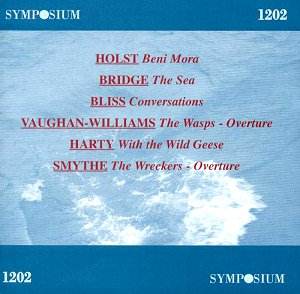British recording studios were busy places in
the 1920s. An earlier generation of senior composers, among them
Elgar, German, Mackenzie and Stanford had made recordings in the
teens of the century but the younger generation also proved attractive
to HMV, Columbia and the newcomer Aeolian Vocalion. The imprimatur
of a composer-led recording was obviously a selling point during
this time, as now, and despite the relative limitations of recording
technology – four of the six works were recorded under the acoustic
system – these are documents of lasting value.
Symposium lead off with the Holst, which as far
as I know has never appeared on CD before. Columbia were making
some fine sounding "new process" records in 1924 but
even they couldn’t quite do justice to a work of diffuse colour
such as Beni Mora. Holst’s ingenious instrumental layering doesn’t
reproduce with any degree of precision in the recording but what
does come across is the characteristically taut Holst hand on
the tiller – brisk tempi, tight rhythms and a powerful sense of
momentum. Frank Bridge was not a keen student of the recording
studio and his conducting was certainly not universally admired.
He complained about the crudity of the recording process and this
recording, of The Sea, in particular. I suspect it was some balancing
exigencies that irked him – the harp is deliberately over recorded
so that it can sound in the balance – as well as a sense of urgency
in matters of tempi. Nevertheless I have to say that whatever
the reduction in the strings the piece still manages to exert
its magic, the portamenti in the Sea Foam movement being succulently
liquid.
Bliss’s Conversations is probably the least well
known of the performances and indeed of the pieces (has it ever
been re-released since its original 78 inscription?) Its very
cosmopolitan wit seldom palls – not least because we hear it so
infrequently– and there is an idiomatic freshness in this performance.
The grandly named symphony orchestra is actually a quintet but
an anonymous one. The original performers back in 1921 were a
redoubtable collection of the wise and the youthful – Charles
Woodhouse, Raymond Jeremy, Cedric Sharpe, Gordon Walker and Leon
Goossens and I’ve a feeling that a few of them are here. VW’s
Wasps gets a fine 100-yard dash of a reading. Vocalion’s pick-up
house band was on hand to supply the thrust and nobility – and
rippling harp near the acoustic horn alongside bass reinforcements
for "downstairs" Pity about the imperfect side join.
Hamilton Harty was no stranger to the recording studios of course,
as soloist, accompanist, chamber player and, not least, conductor.
This is the first of the two electrics and is a passionate and
vibrant reading of this noble score. One can admire the very distinctive
timbres of many of the Hallé’s principals as well as the
stirring portamenti of the violin section whose playing of Harty’s
cantilena is memorable. Ethel Smyth recorded the overture to The
Wreckers in 1930 – a typo has her as ‘Smythe’ in the booklet.
She may have been an utter pain to Thomas Beecham, Adrian Boult
and anyone else who conducted her music but she proves a bold
and imaginative conductor of her own music – presumably after
ticking herself off a few dozen times. Saturated though it is
in Wagnerian power it strikes a lyrical and forward moving note
in this incisive and well-recorded performance.
The copies used are pretty good. Engineering
has been discreetly applied. In the days of the LP Pearl issued
a few of these performances, along with a number of other conductor
led works, but Symposium’s transfers are comfortable and easy
to listen to.
Jonathan Woolf
